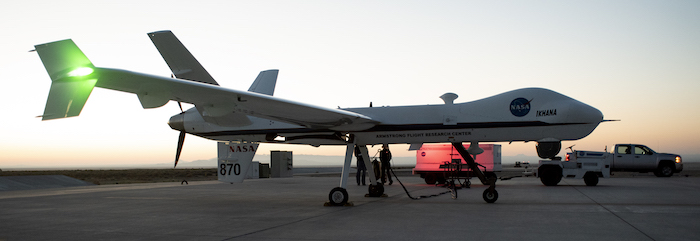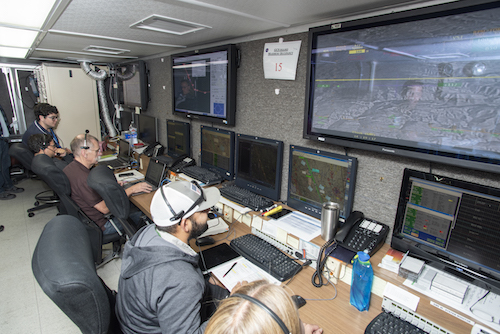
Aircraft maintenance crews at NASA‘s Armstrong Flight Research Center prepare the remotely-piloted Ikhana aircraft for a test flight June 12, 2018. The test flight was performed to validate key technologies and operations necessary for the Federal Aviation Administration’s approval to fly the aircraft in the public airspace without a safety chase aircraft. Credits: NASA/Ken Ulbrich.
The National Aeronautics and Space Administration (NASA) recently announced the agency’s remotely-piloted Ikhana unmanned aircraft successfully completed its first flight within the National Airspace System (NAS) without the use of safety chase aircraft. This accomplishment is an important step towards the incorporation of unmanned aircraft within the NAS for various applications including the monitoring of forest fires, search and rescue operations and even general aviation.
According to NASA’s report, the unmanned Ikhana flight took off from Edwards Air Force Base in southern California and quickly entered Class-A airspace, the airspace where commercial airliners fly, at an altitude of about 20,000 feet. The aircraft headed north towards Fresno, CA, and on its return the craft began a descent to 9,000 feet MSL (the unit of measure for altitude above airport elevation) into Class-E general aviation airspace over the city of Tehachapi, CA. The craft then initiated an approach into the airport in Victorville, CA, at an altitude of 5,000 feet, transiting its Class-D terminal airspace, before exiting the NAS and returning to its base at the Armstrong Flight Research Center. The path of the flight required the transfer of air traffic control between bases in Los Angeles and Oakland as well as communication with air traffic controllers at the Victorville airport, all of which was completed successfully. According to Mike Marston, the lead operations engineer on the UAS Integration in the NAS project, the aircraft traveled approximately 415 nautical miles and spent a total of about two-and-a-half hours in the NAS.
Ikhana, which takes its name from a Native American Choctaw word for “intelligence,” was first acquired by NASA in November 2006 to serve in Earth science missions and advanced aeronautical technology development. The craft itself is a MQ-9 Predator B unmanned aircraft system (UAS) which was purchased from UAS developer General Atomics Aeronautical Systems Inc. Ikhana has a length of 36 feet, a wingspan of 66 feet and has a maximum takeoff weight of 10,500 pounds. The craft is powered by a Honeywell TPE331 turboprop engine with digital electronic engine control and a three-blade constant-speed propeller enabling control of the aircraft at altitudes greater than 40,000 feet.
Included in Ikhana’s payload is more than 3,000 pounds worth of equipment including radar, sensors, communication and imaging tools. Communication links installed on the aircraft include both line-of-sight as well as satellite command and control links. During the recent unmanned flight, Ikhana was outfitted with air-to-air radar (ATAR) systems from General Atomics, a traffic alert and collision avoidance system (TCAS) from Honeywell, a detect and avoid fusion tracker and an automatic dependent surveillance-broadcast (ADS-B) In/Out technology which uses satellite navigation to determine the aircraft’s position and then broadcasts that position to other aircraft. Regulations from the Federal Aviation Administration (FAA) requires that all aircraft operating in the U.S. airspace incorporate ADS-B Out devices by January 2020; Ikhana’s ADS-B In device offers additional functionality as an onboard surveillance sensor for detect and avoid (DAA) purposes.
“What’s unique about the Ikhana among UAS vehicles is that it has airborne surveillance sensors which it uses as part of its detect and avoid technology,” said Sam Kim, a NASA project engineer involved with NASA’s UAS-NAS Project. Kim pointed to the ATAR, TCAS and ADS-B technologies as the three main technologies enabling Ikhana’s unmanned flight in civilian airspace. “Other UAS vehicles don’t have those,” he said, adding that Ikhana is the first UAS to incorporate both these sensors and the DAA algorithm as an alternate means of compliance to FAA “see and avoid” rules. According to Kim, the TCAS and ADS-B technologies are considered to be collaborative systems because they rely upon data transmitted by sensor technologies equipped on other aircraft. FAA regulations require passenger aircraft carrying more than 19 passengers to be outfitted with TCAS sensors but UAS vehicles like Ikhana don’t have the same requirements. “The TCAS system is used as a sensor for surveillance to see other airplanes and build a picture,” Kim said. Data collected by TCAS, ADS-B and ATAR is processed by the detect and avoid fusion tracker to fuse data from the different sensors to provide pilots with a highly accurate target report. This overcomes shortcomings in sensor technology such as radar’s less accurate altitude determination, something that TCAS sensors are more adept at performing. “Software algorithms analyze sensor data for the pilot in the ground control station to avoid a potential loss of well clear,” Kim said. “The function of the DAA system is to affect the maneuvering far enough in advance that what we are working on doesn’t trigger collision avoidance by notifying pilots of a predicted loss of well clear.”
The FAA granted special authority to NASA in late March for conducting this flight without the use of safety chase aircraft. Such chase aircraft is usually required to ensure that UAS aircraft is able to safely traverse airspace in which commercial airliners also operate. According to NASA, Ikhana was compliant with two technical standard orders published by the FAA covering detect and avoid systems as well as air-to-air radar for traffic surveillance.
Early missions for Ikhana include participation in the Western State Fire Mission between 2007 and 2009, a project designed to improve wildfire imaging and mapping capabilities. During the wildfire missions, Ikhana’s instrumentation pod was outfitted with autonomous modular sensor tech which allowed visibility through thick smoke to improve the recording of both hot spots as well as the progression of wildfires over periods of time. In 2008, Ikhana tested a patented fiber optic sensor system which was capable of measuring changes in the craft’s wing shape during flight, an effort which NASA notes was one of the first validations of fiber optic sensor technology during a comprehensive flight scenario. In 2013, one year after ADS-B technology was installed on the craft, Ikhana underwent a major upgrade to its avionics system and received a new instrumentation pod capable of carrying more than 500 pounds in generic science payload.
Ikhana receives its flight navigation instructions from a ruggedized mobile ground control station which hosts the pilot control station, engineering monitoring workstations, science monitoring stations and range safety oversight. The aircraft itself is capable of being disassembled through removal of the wings, tails and propeller from the main modular unit so that both the craft and the mobile control station can be deployed internationally; the control station itself is suitable for ship-based applications for the use of Ikhana over ocean waters. Although Ikhana requires a human operator to control the craft, NASA engineers are currently working on an airborne research test system (ARTS) capable of being integrated into Ikhana’s flight control systems for the completely autonomous command of the aircraft. ARTS would also be capable of monitoring the health of Ikhana in service to the aircraft’s aeronautics and earth science goals.

Engineers at NASA‘s Armstrong Flight Research Center monitor the remotely-piloted Ikhana aircraft from a mission control room during a test flight June 12, 2018. Credits: NASA/Ken Ulbrich.
Although the development of UAS vehicles for commercial passenger flight is still a long ways off, Marston indicated that he didn’t see why technological development wouldn’t head in that direction over time. “The low-hanging fruit would probably be cargo operations such as transatlantic or transpacific flights which are pretty scripted routes,” he said. “Down the road, there’s probably a place for pilotless flights on commercial passenger airliners, but we have to convince the FAA and the public that it’s safe.” Marston noted that driverless cars would likely be a reality before pilotless aircraft, and even driverless cars will require more development before their widespread use. “This is a first step. It’s a bold step for both NASA and the partners that we worked with to get this initial step of unmanned aircraft operating seamlessly in the NAS.”
“One of the things that we got a front row seat to by conducting this flight demonstration was the human element of interacting with air traffic controllers,” Kim said. “We got the trust of air traffic control even though we’re a UAS vehicle out there without a chase airplane. They treated us like any other airplane and called out air traffic to us. In one instance, ATC called out a VFR opposite direction traffic with an estimated altitude due to its intermittent transponder. This traffic was tracked by the ATAR and the Ikhana pilots replied to ATC with ‘traffic detected.’ This was an important element of interacting with ATC and another first in that at this moment, ATC stopped providing any further advisories on that VFR traffic since the Ikhana pilots acknowledged what was analogous with a manned aircraft reporting ‘traffic in sight.’ We have to convince air traffic control that we’re safe. The demonstration was a small step but it’s definitely a step in the right direction.”

![[IPWatchdog Logo]](https://ipwatchdog.com/wp-content/themes/IPWatchdog%20-%202023/assets/images/temp/logo-small@2x.png)

![[[Advertisement]]](https://ipwatchdog.com/wp-content/uploads/2024/04/Patent-Litigation-2024-banner-938x313-1.jpeg)
![[Advertisement]](https://ipwatchdog.com/wp-content/uploads/2024/04/UnitedLex-May-2-2024-sidebar-700x500-1.jpg)
![[Advertisement]](https://ipwatchdog.com/wp-content/uploads/2024/04/Artificial-Intelligence-2024-REPLAY-sidebar-700x500-corrected.jpg)
![[Advertisement]](https://ipwatchdog.com/wp-content/uploads/2024/04/Patent-Litigation-Masters-2024-sidebar-700x500-1.jpg)

![[Advertisement]](https://ipwatchdog.com/wp-content/uploads/2021/12/WEBINAR-336-x-280-px.png)
![[Advertisement]](https://ipwatchdog.com/wp-content/uploads/2021/12/2021-Patent-Practice-on-Demand-recorded-Feb-2021-336-x-280.jpg)
![[Advertisement]](https://ipwatchdog.com/wp-content/uploads/2021/12/Ad-4-The-Invent-Patent-System™.png)






Join the Discussion
No comments yet.